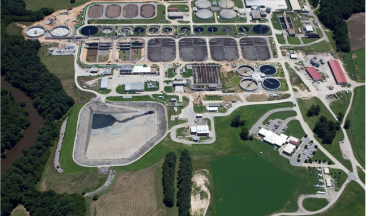Jump To:
Treatment Plant Tours
Do you know how water gets to your faucet and the processes that happen to ensure its quality and safety?
Have you ever wondered what happens to the dirty water from your shower, bath, laundry and toilet after it goes down the drain?
We invite you to take a free tour of our water or wastewater treatment plants to find out how our utility system works.
E.M. Johnson Water Treatment Plant
Treats water from Falls Lake:
- Treats 41 million gallons per day on average
- Maximum treatment capacity of 86 million gallons
Recognition:
- 2013 though 2019 Partnership for Safe Water Directors Award from American Water Works Association
- 2013 though 2019 Area Wide Optimization Program Award from the North Carolina Department of Environmental Quality
Dempsey E. Benton Water Treatment Plant
Treats water from Lake Benson:
- Treats 10 millions gallons per day on average
- Maximum capacity of 20 million gallons per day
Recognition
- LEED silver certified facility
- 2014 though 2019 Partnership for Safe Water Directors Award from American Water Works Association
- 2013 though 2019 Area Wide Optimization Program Award from the North Carolina Department of Environmental Quality
Neuse River Resource Recovery Facility (formerly Neuse River Wastewater Treatment Plant)
Volume
- Treats 50 million gallons per day
- Maximum capacity of 75 million gallons per day
- Treats over 18 billion gallons of wastewater per year year
Recognition
- Has 16 consecutive years of 100% compliance with a clean performance record
- Received a Platinum 16 Award issued by the National Association of Clean Water Agencies in 2018
- LEED silver certified Administration and Training facility
Smith Creek Wastewater Treatment Plant
Originally served Wake Forest & Transferred to Raleigh on July 1, 2005
Volume
- Maximum capacity of 3.0 million gallons per day
- Treats approximately 554 million gallons of wastewater per year
Recognition
- Has 14 consecutive years of 100% compliance and a clean performance record
- Received the Platinum 14 Award issued by the National Association of Clean Water Agencies in 2018
Little Creek Wastewater Treatment Plant
Originally served Zebulon & Transferred to Raleigh on October 1, 2006
Volume
- Maximum capacity of 2.2 million gallons per day
- Treats approximately 322 million gallons of wastewater per year
Recognition
- Has four consecutive years of 100% compliance with a clean performance record
- Received the Gold 4 Award issued by the National Association of Clean Water Agencies in 2018
Wrenn Road Facility
The Wrenn Road Facility, located in Garner, became a City asset upon utility system merger agreement with the Town of Garner. Consisting of over 600 acres of fields and woodlands, the facility was originally used to treat wastewater collected from the sewer system serving most of the Garner area. The facility has not received waste from the sewer system since 2008, when all wastewater flow was permanently redirected to the Neuse River Resource Recovery Facility. Operations at this site have since been repurposed for the management of residuals generated by operation of the Dempsey E. Benton Water Treatment Plant. These residuals are composed of the lake sediments and other particles that are removed from the water during the production of potable water. Water plant residuals are currently land applied and irrigated onto hay fields, and hay is baled and sold to local area farmers.
Water Treatment Process
The treatment process used at the new Dempsey E. Benton Water Treatment Plant begins with adding ozone to the raw water and ends with ultraviolet (UV) disinfection and chloramination.
Suspended solids is coagulated with ferric sulfate, settled in a solids contact clarifier, and gravity fed through a two-stage filtration system.
The filtered water is then disinfected with both ultraviolet light and chloramines before it is stored in a 5-million gallon, on-site storage reservoir. From the storage reservoir, water is pumped directly to customers in Raleigh and Garner.
Wastewater Treatment Process
Advanced or tertiary treatment means that wastewater undergoes three stages of treatment: primary, secondary and advanced treatment.
- Primary treatment is a physical process removing debris, sand, heavy organic solids, and grease and oils.
- Secondary treatment is a biological process referred to as "activated sludge" in which microorganisms convert ammonia-nitrogen to nitrogen gas through the process of nitrification/denitrification. Secondary clarification separates the microorganisms from the treated water and returns them to the biological process.
- Advanced treatment is the process of filtering the clarified water in sand filters and disinfecting the water by ultraviolet (UV) light before the water is metered and returned to the Neuse River.
